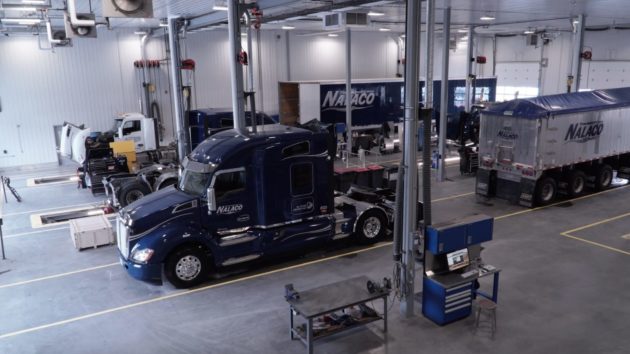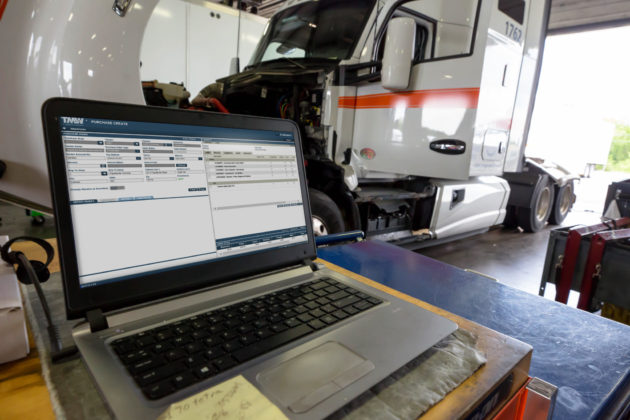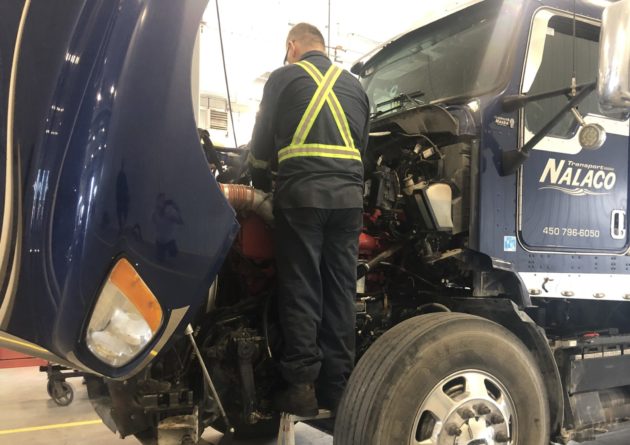These are digital days for fleet shops

Transport Nalaco was clearly in a growth mode. About two years ago it had expanded to 75 power units, almost triple its previous size. But the success was breeding a new sort of challenge – a lack of visibility into maintenance activities.
It quickly became clear that the Saint-Hyacinthe, Que. fleet was outgrowing the paper-based system used to manage the tasks.
“Just the follow-up on kilometers traveled per week and preventive maintenance such as greasing or oil drains had become a source of headaches,” says Steve Dillaire, general manager of Nalaco’s parent company, Jefo Logistique.
The decision to embrace maintenance software immediately made it easier to trace activities, he said. Savings emerged through parts orders and warranty claims alike.
Technicians no longer need to rely on the dealer to confirm if a part is under warranty. The new computerized system will even notify technicians that a specific component’s warranty is about to expire, and that any major repair should be performed before the fleet has to pay for it.
The information transparency that allows such preventive actions begins the moment equipment is purchased, too. “When a new truck comes in, we enter all the warranty information for different major components in the system,” Dillaire explains.
Shedding the paper
Renaldo Adler, industry principal for asset maintenance at Trimble Transportation, thinks that “paper really generates a backlog of work”. Look no further than those who try to map out their plans using massive sheets of paper taped onto the wall.
“They pull that piece of paper off at the end of the day and then rewrite it for the following day. That’s very manual,” Adler says.
And the more any business relies on manual data entry, the more the business is subject to lost time or human error.

“Software research tools make it much easier and quicker to track information compared to going over numerous paper files,” says Guillaume Laliberté, sales manager of DataDis, a maintenance management software company headquartered in Quebec City, with a satellite office in Toronto and a new one to open in Florida.
Trimble’s Adler couldn’t agree more, and sees another benefit to eliminating paper files.
“Some shops have file cabinets with every repair order from 1942 that they worked on,” he says, referring to the space that could be assigned to other uses. The same volume of inspection reports, work orders, and warranty documents could fit on a single hard drive, and easily be backed up on a remote server to ensure the information is protected from fire or water damage.
The digital approach also gives technicians access to complete vehicle service histories no matter where the work is performed, Adler says. Tracking such details using paper documents would be no small task.
Rather than flipping through piles of paper, a technician might decide it’s quicker to perform a small maintenance task like a $50 oil change rather than confirming whether the work was recently performed, DataDis’ Laliberte says. The small, avoidable maintenance expenses like these can add up over time.
Aggregating the information
Digitizing the information from drivers can generate savings for operations teams as well as those in the shop, Dillaire says.
Before shifting to a paperless systems, Nalaco drivers who had trouble with a tractor or trailer might bypass managers and take their issue straight to a mechanic. That made it difficult to identify systemic problems.
“Now he needs to enter any issue on his tablet,” Dillaire says. The underlying information systems can generate reports based on kilometers traveled or any other measure – delivering an accurate look at the true cost per kilometer.
Since all mechanical issues are electronically entered into the system as they arise, they are properly planned for the moment a truck enters the service bay, rather than waiting for a driver to remember at the last minute that something else needed to be addressed.
“You could have had scheduled a truck for a four-hour time slot based on the paper reports you had from a driver, and it would end up requiring to stay two days in the shop,” Dillaire says.
Such unscheduled downtime could negatively affect dispatching and customer service as well.
“Surprise management” is another area where fleet maintenance software can help through improved flexibility and accuracy. If a technician discovers that a wheel bearing is leaking while performing a simple replacement of friction material, it’s much easier to update a work order with an electronic tool rather than preparing a completely new paper work order or writing new details over an existing document.
“Just like in F1 racing, trucks eventually have to make pit stops, but you want these stops to be optimized so that the trucks get back on the road as quickly as possible, where they generate revenue,” Laliberté says, referring to the accuracy of automation. “When the truck arrives at the shop for routine maintenance, the technician will have a complete listing of everything that has to be done on that unit.”
The aggregated information can help identify routes that cause more failures, establish standard repair times (SRTs), and show that additional training may be required for a technician who tends to lag behind his peers. And technicians who are particularly quick at certain types of jobs can be assigned to the roles as a repair specialist.
“The service writer gets a real-time view of what’s going on in the shop, without having to walk around and check on everybody,” Adler says.
An added advantage is that the data makes it possible to focus on a piece of equipment’s reliability metrics rather than going with “gut feelings” about particular brands or model years.
The process can even help to track down the root cause of a problem, whether it involves a shortcoming in equipment or a driver who needs additional training, says Nalaco’s Dillaire.
Preparing your staff
While people tend to resist change, implementing maintenance management software can be pretty painless compared to a couple of years ago, Adler says. “Those guys, they go to the ATM machine to get out money, they go to the airport and get on planes, so interacting with a computer is not as a big challenge as it used to be.”
According to him, the technology could even help attract new, younger workers in modern shops. “They want to work with the latest technology. They want to be moving forward.”

Preparing for the transition is still necessary, though. “Our watchword to customers is always to prepare their staff,” DataDis’ sales manager says, referring to parts clerks and technicians alike.
The solutions need to be user-friendly to gain acceptance. And the training programs will be embraced more quickly when trainers use data coming from the fleet’s actual vehicles, suppliers or parts inventories, Laliberté adds.
Familiarizing technicians with Vehicle Maintenance Reporting Standards (VMRS) codes developed by the American Trucking Associations can help as well, Adler suggests. “Everything [part or component] has a number that identifies what it is, for instance that it’s a brake shoe. That’s where the technicians need to become a little more familiar from a coding standpoint.”
The largest players in the trucking industry are all working on some type of system, the Trimble representative says. But he knows that many smaller fleets continue to rely on paper and white boards.
“If you’re not doing it now, you’re behind,” Adler says. “Very behind.”
www.trucknews.com/digital-archive/maintenance-best-practices-vol-3/
Have your say
This is a moderated forum. Comments will no longer be published unless they are accompanied by a first and last name and a verifiable email address. (Today's Trucking will not publish or share the email address.) Profane language and content deemed to be libelous, racist, or threatening in nature will not be published under any circumstances.